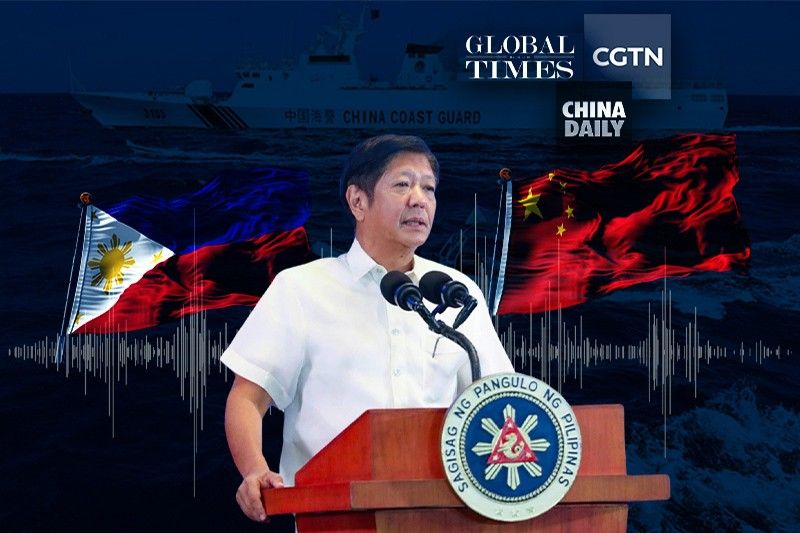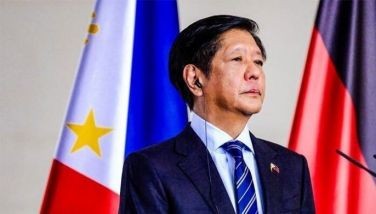Chinese media pushes 'Philippines as aggressor’ narrative before viral Marcos deepfake

A relentless months-long campaign by Chinese state media to depict the Philippines as the aggressor in the South China Sea preceded the viral spread of the “deepfake” audio of Marcos allegedly ordering an attack on China.
MANILA, Philippines — Chinese state media have routinely portrayed the Philippines as a provocative and aggressive country in the West Philippine Sea following the private meeting between former President Rodrigo Duterte and Chinese President Xi Jinping in July 2023, with most articles published right after an altercation between the two countries in the tense waterways.
Every month since August 2023, the Chinese Communist Party’s propaganda apparatus has published news articles or editorials that claim the Philippines was “stirring up trouble” or “making provocations at sea,” typically hours or days after Chinese vessels block or attack much smaller Filipino boats.
Philstar.com’s monitoring over nine months found more than 60 such articles and/or statements from media outfits owned or associated with the Chinese government. Most statements are published by People’s Daily and The Global Times, newspapers controlled by the Chinese Communist Party.
While local media and influencers targeting Filipinos have not echoed this narrative on the same scale, there appeared to be a recent attempt to sow confusion among Filipinos over whether the Philippines was an aggressor. This was done through the recently viral “deepfake” audio of President Ferdinand Marcos Jr. supposedly ordering the military to attack China — the origins of which remain unknown but is believed to have come from a foreign source.
Besides framing the Philippines as an instigator, Chinese social media influencers and anonymous accounts have also pounced on the Duterte-led Mindanao independence campaign in the Philippines to spread rumors of an all-out civil war in the country.
These articles have some of the markings of an influence operation that Philstar.com is tracking across all social media platforms, groups and spaces on the internet.
Marcos’ ‘strikingly different’ stance on West Philippine Sea
In July 2023, the Philippine government issued a statement commemorating the seventh anniversary of the 2016 Hague ruling that invalidated China’s sweeping claims in the South China Sea. The Department of Foreign Affairs called the ruling a “settled landmark” and a “shining beacon of internal law practice.”
China, which has never accepted the arbitral decision, said in a report by the Global Times that this was a “strikingly different” statement from the Philippines. Citing “experts,” the report said that the wording used by the Philippines showed the country was “growing tougher in its stance.”
Exactly a week after the publication of the statement, Duterte met with Xi behind closed doors, where Duterte reportedly expressed support for “friendlier” Philippines-China relations, according to a Global Times report.
Thus began the pattern. For almost a year, every time Chinese vessels block or attack a Philippine vessel in the West Philippine Sea, usually during resupply missions to the Ayungin Shoal, Chinese state media would quote Chinese officials who have concluded that Philippine vessels’ “aggressive actions” and “dangerous maneuvers” provoked Chinese vessels to respond.
The pattern was observed first in August 2023 when Chinese Coast Guard vessels shot water cannons at PCG during a resupply mission for military troops in Ayungin Shoal.
A day after the incident, People’s Daily Online published an article quoting Wu Qian, spokesperson for the Chinese ministry of national defense, who said that the Philippines must “cease provocation” and that they will continue to safeguard their territory.
This pattern was repeated seven times more monthly from September to March, where encounters between Chinese and Philippine vessels were attributed to the Philippines’ “dangerous provocations” at sea.
December escalation
In December, a wider network of Chinese state media and Facebook pages amplified the narrative that the Philippines often provoked Chinese vessels in the tense waterways, thus reaching a larger audience.
In two separate incidents on December 9 and 10, the CCG and the Chinese Maritime Militia fired water cannons at Philippine vessels resupplying Filipino fishers and the anchored BRP Sierra Madre.
In one of its most aggressive maneuvers in 2023, on December 9, Chinese Coast Guard vessels repeatedly fired three Bureau of Fisheries and Aquatic Resources vessels with water cannon blasts. Suspected militia ships also reportedly used painful sound blasts that temporarily affected Filipino crew members’ hearing.
The next day, the CCG rammed and fired water cannons at Philippine vessels engaged in a resupply mission to military personnel stationed on BRP Sierra Madre.
Both incidents were immediately depicted by Chinese state media and state agencies as the result of the Philippines’ “dangerous” actions in the South China Sea. For instance, CGTN, the English-language news channel of state-run China Global Television Network, said the December 10 incident was caused by the Philippine vessels that “swerved in an unprofessional and dangerous manner.” The CCG also accused a Philippine boat of “deliberately colliding” with a Chinese vessel after “disregarding our multiple stern warnings.”
On Dec. 18, 2023, the Chinese foreign ministry accused the Philippines of repeatedly dismissing “China’s goodwill and restraint and challenged China’s principles and red line with repeated provocations.”
The Chinese Embassy in Manila on Dec. 24, 2023, said in a Facebook post that certain Filipino politicians have manipulated the narrative to proliferate anti-China sentiments among Filipinos.
Meanwhile, there was a sudden surge of social media posts and articles depicting the Philippines as an aggressor after The People’s Daily published a story that alleged the Philippines made "repeated provocative moves" in the South China Sea and ignored China’s “goodwill and restraint” on December 27.
Monitoring by Philstar.com and the Taiwan-based Doublethink Lab shows that Beijing’s information campaign involved over 20 social media posts and articles that either reposted the People’s Daily article word-per-word or used nearly the same keywords, such as the Philippines being “extremely dangerous” or “ignoring China’s goodwill.”
On the same day, Facebook page We Are China, labeled as a “China state-controlled media” by the social media platform and which has 25 million followers, also posted a snippet and a link to the article.
Beijing-affiliated accounts were not the only accounts to disseminate the narrative. Alongside Voice of the People and The People’s Daily Online official channels, Samachar Dainik from Nepal, Korea Post, and a dubious website of the Subic Bay Naval Station reposted the China-controlled state media’s article on December 28, 2023.
The Subic Bay Naval Station publishes other defense-related news but also uploads content related to hotels and resorts.
Filipino ‘experts’ echo narrative
Two Filipino experts leading the think tank Asian Century Philippines Strategic Studies Institute (ACPSSI) have also spread this narrative either by granting interviews to Chinese state media or through local forums and news reports.
Herman Tiu Laurel, president of ACPSSI, said in a CGTN video on December 23 that the Philippine Coast Guard and “some civilian Filipino boats” have been provoking Chinese vessels based on the orders of the United States government through a certain “project Myoushu.”
Laurel is also the host of Global Talk News Radio, a radio show broadcasted by Radyo Pilipinas, the flagship government AM radio station of the Philippine government’s Presidential Broadcast Service. A quick scan of the Facebook page of his radio program shows that it also spreads similar pro-China narratives on the social media platform.
Similar to the keywords used by Chinese state media, ACPSSI posted an article on December 28 that claimed the Philippines is “stirring up trouble,” “building up hype” and creating “publicity stunts” in the WPS.
Besides Laurel, ACPSSI vice president for external affairs, Anna Malindog-Uy, has also been repeatedly quoted by Chinese state media as saying that the Philippines is an instigator in the WPS.
A Filipino-language Facebook page named CRI Filipino Service, labeled by the social media platform as “China state-controlled media,” also posted on December 29 claiming the same narrative. The page has around 1.2 million followers.
Lead up to Marcos’ deepfake
After the barrage of narrative attacks in December, January 2024 saw no direct incidents between the two countries, but there was still an attempt from Beijing-linked media to paint the Philippines as an aggressor.
Quoting certain “analysts,” a China Daily article on January 29 again pressed the Philippines to cease its “provocations” in the South China Sea, a week after the Philippine Navy air dropped supplies for personnel at the BRP Sierra Madre.
The pattern continued in February and March. On the morning of March 23, video footage captured China using water cannons against smaller Philippine vessels during their routine resupply mission to the BRP Sierra Madre.
Two days later, Hua Chunying from China's foreign affairs ministry posted an infographic on X accusing the Philippines of "playing victim after provocation” and said that China has tried to resolve disputes through dialogue.
Hua’s post earned over 2,100 likes and 1,300 reposts.
In April, Marcos became the subject of an “audio deepfake” clip that depicted him directing the Philippine military to act against China.
Days after the video was uploaded on YouTube, anonymous accounts on two Chinese social media platforms, Baijahao and NetEase, spread the narrative that the United States was behind the AI-generated audio to worsen tensions between the Philippines and China.
The source behind a widely circulated deepfake audio of President Ferdinand Marcos Jr. telling the Armed Forces of the Philippines to launch an attack against China has yet to be identified pending an official investigation launched by the Philippine government.
— Philstar.com (@PhilstarNews) May 13, 2024
But a couple of… pic.twitter.com/9iv3Zwh3iA
— With reports by Doublethink Lab, John Marwin Elao, Christian Patrick Laqui
--
This alert/analysis/series was produced with support from an Internews initiative aiming to build the capacity of news organizations to understand and monitor disinformation and influence operations in the Philippines.
- Latest
- Trending





























